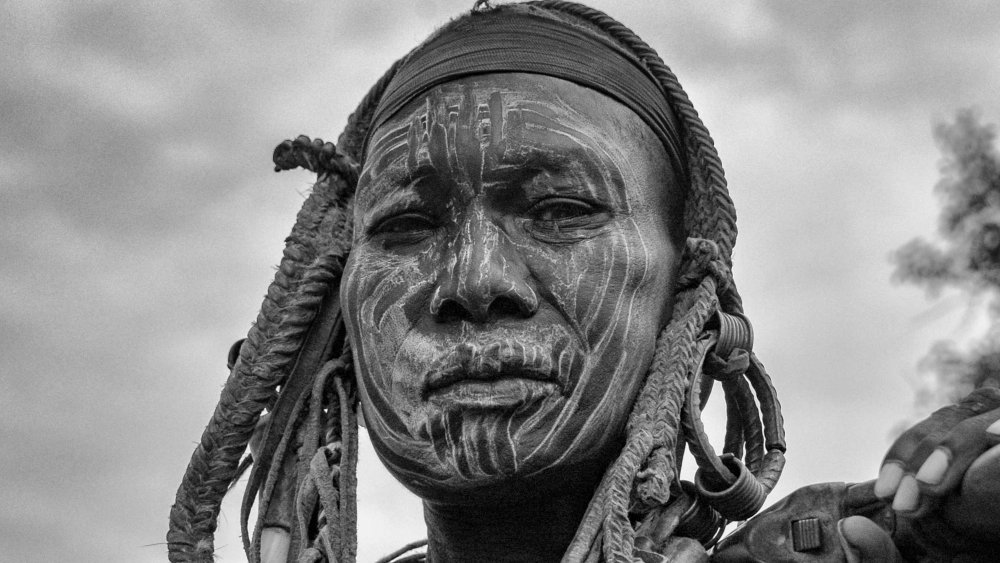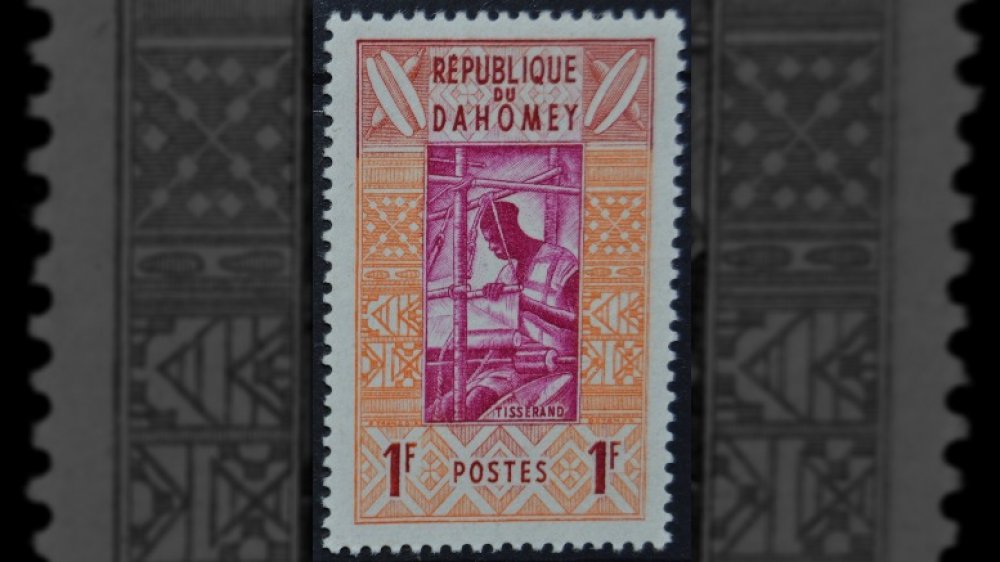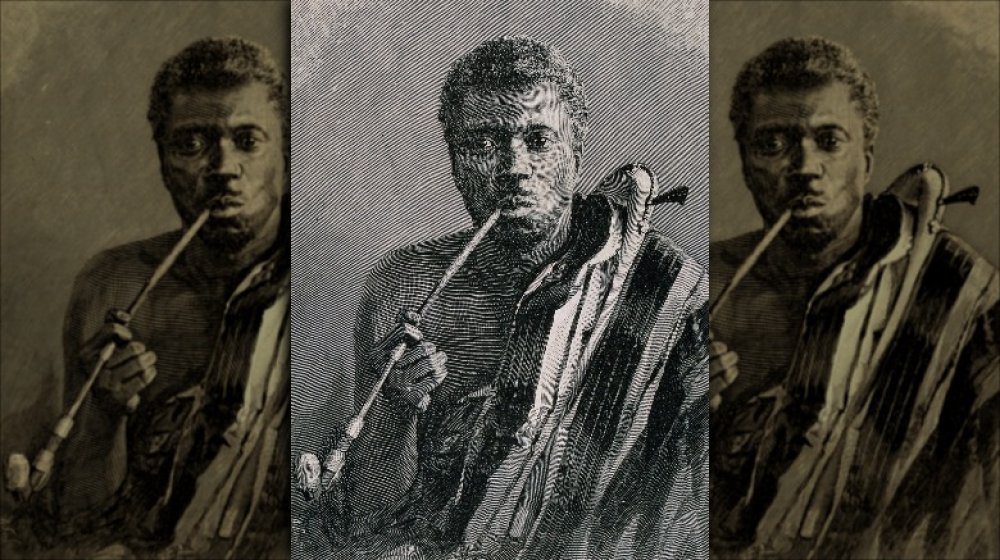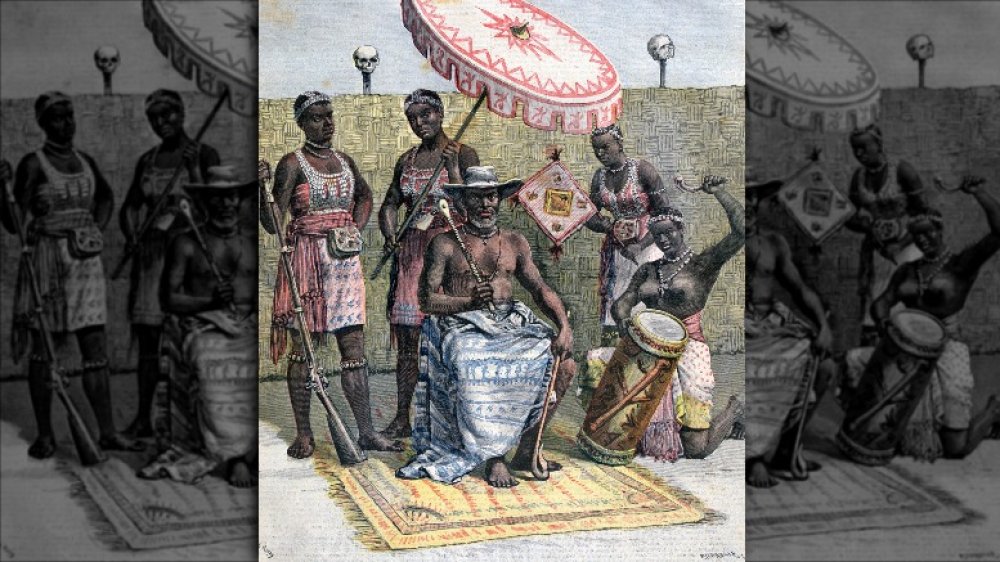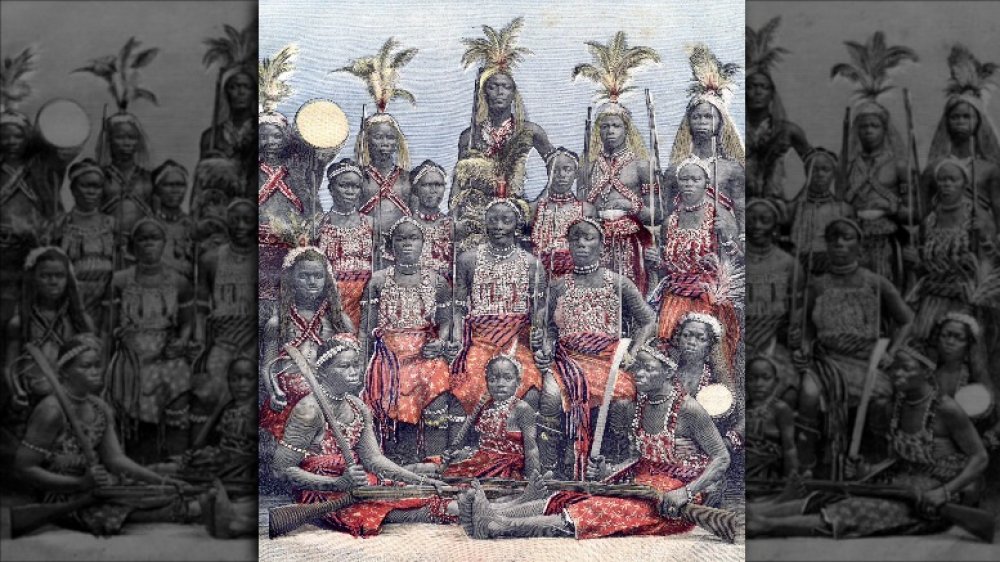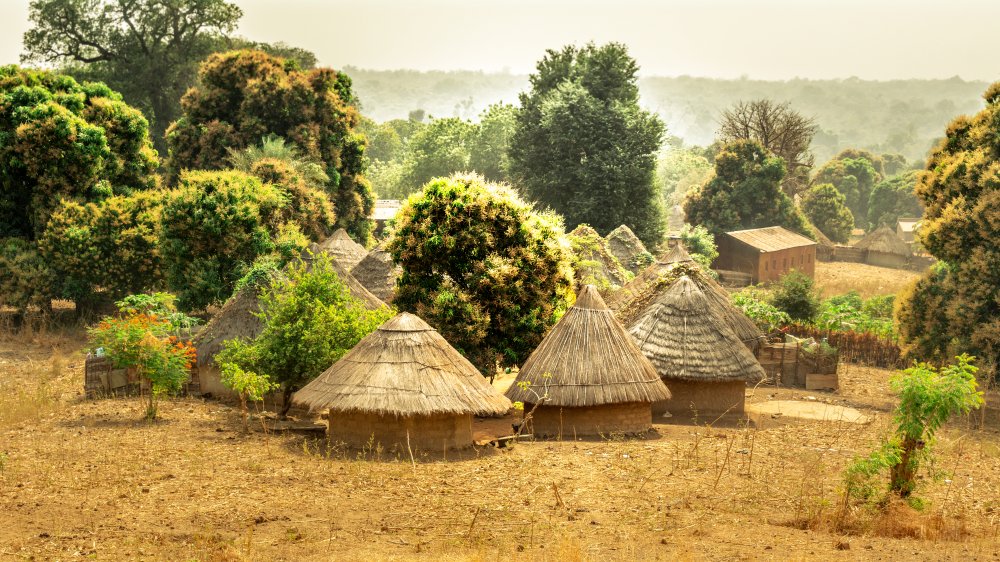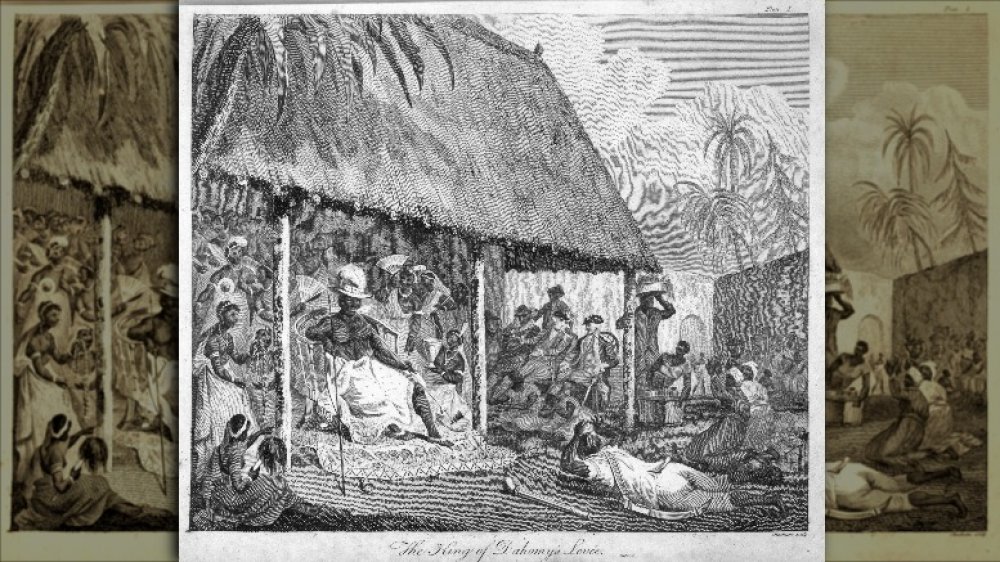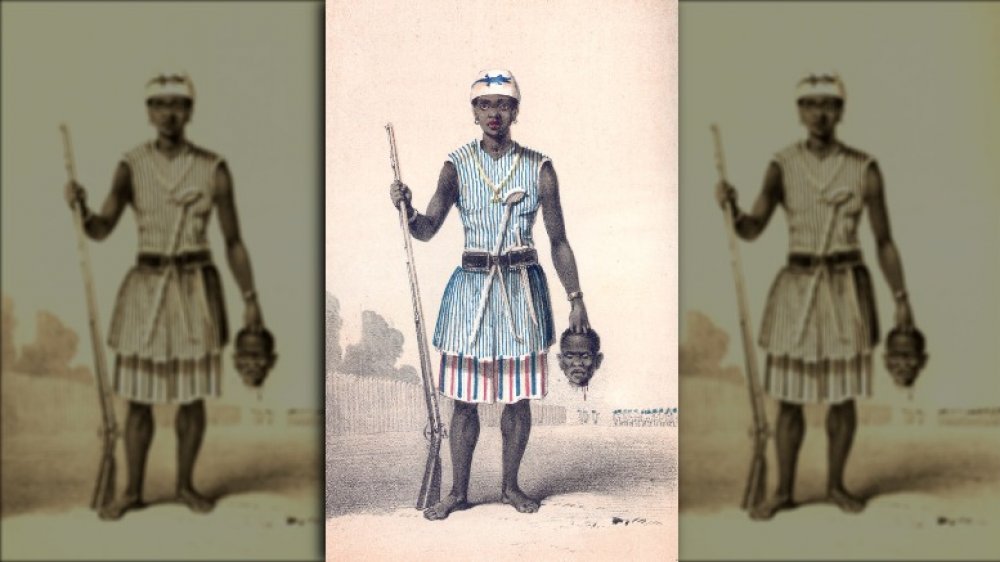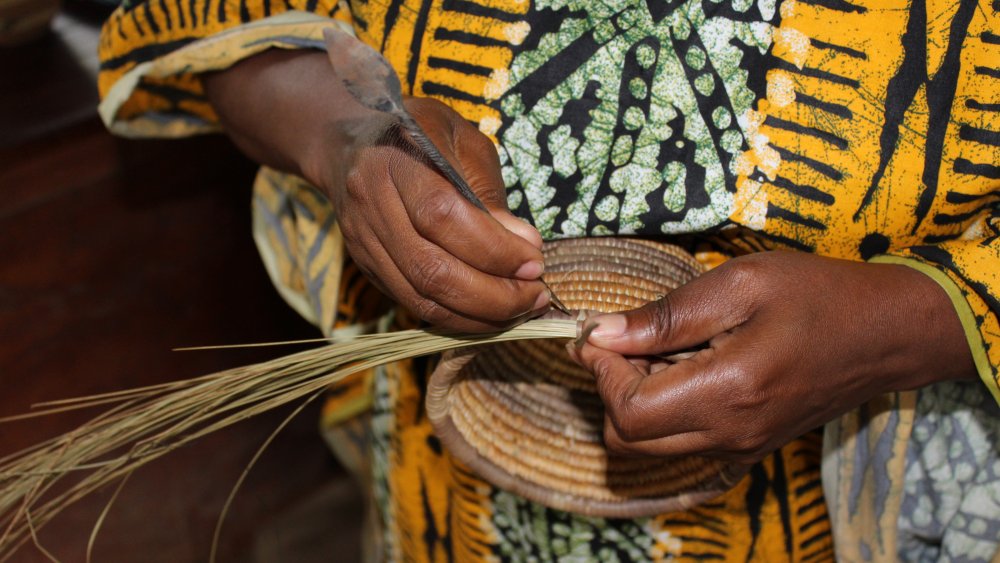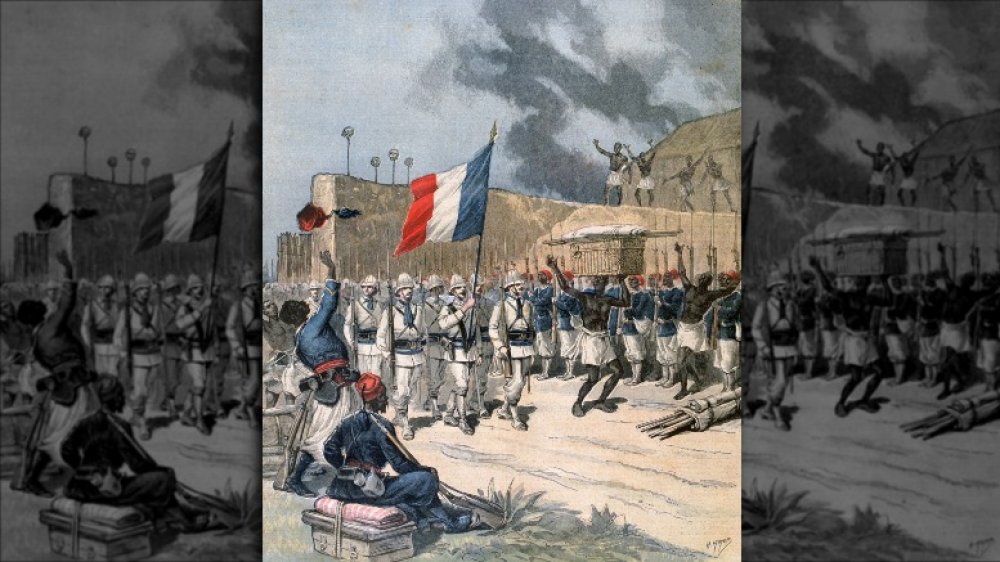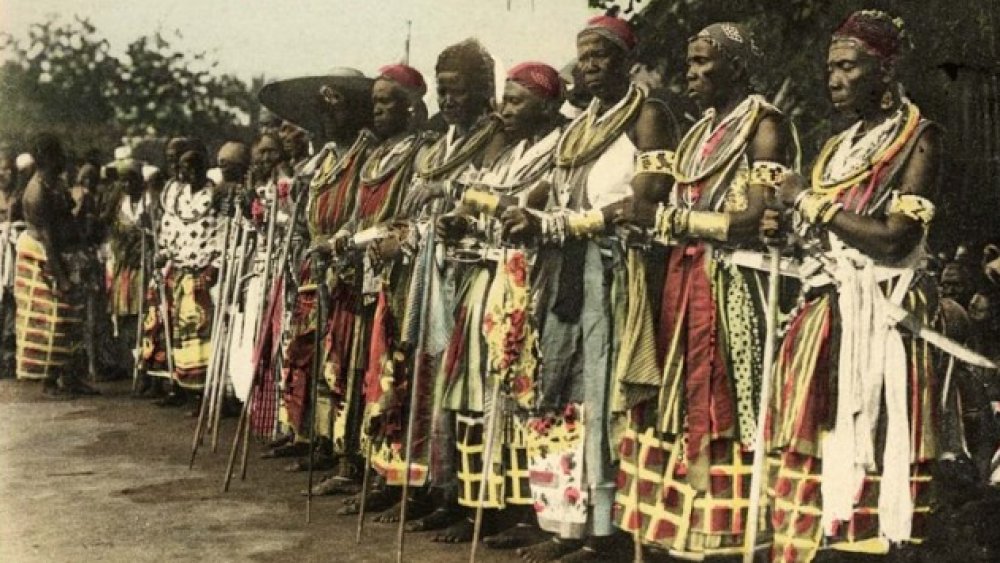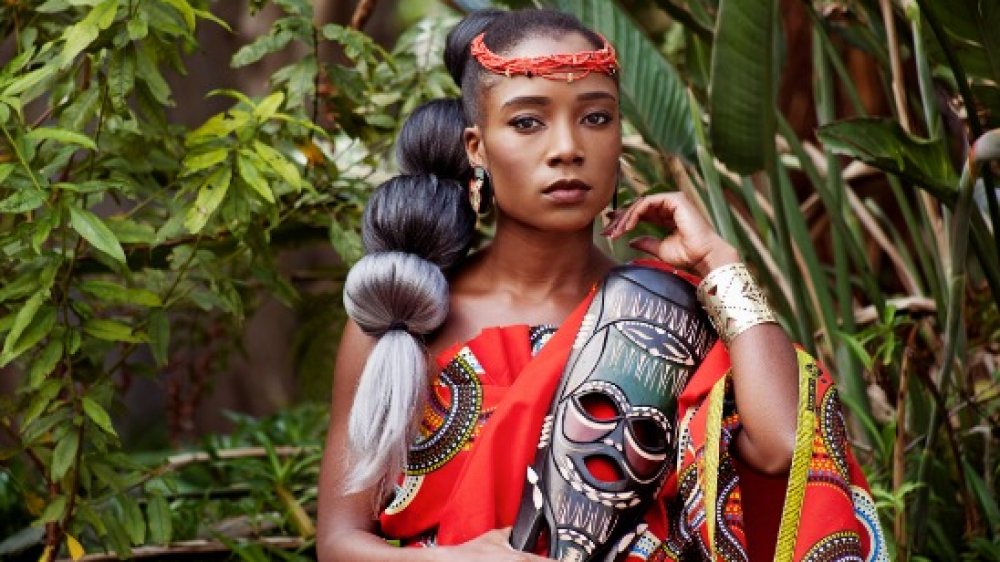The True Story Of West Africa's Real-Life Warrior Women
We may receive a commission on purchases made from links.
The new recruit walked up to the prisoner swinging a razor-sharp sword. Grinning, the warrior decapitated the target with a single blow and then cleaned the blood off the blade and swallowed it, becoming a full member of an elite fighting corps with that first taste of human blood. Was this a fierce soldier from ancient Sparta? A terrifying warlord from Genghis Khan's legions? A stalwart samurai? Nope, it was a 16-year-old West African girl in 1889.
According to French observer Jean-Marie Bayol, carrying out an execution, either by sword or by simply chucking a captive to a waiting mob, was the last step in becoming a member of the army of the Kingdom of Dahomey. And the most feared — and skilled — of these warriors were the ahosi, a troop of women known far and wide for their bloodthirsty combat prowess.
That's right, kids – Black Panther wasn't making stuff up. Until 1892, there was an active, ruthless female fighting force in West Africa, whose idea of a great Friday out was killing an elephant for fun. With their bare hands.
Who were the Dahomey?
From around 1600 until 1904, the Kingdom of Dahomey was the dominant power in West Africa, according to Dr. Toby Green. Centered around modern-day Benin, the kingdom arose out of a power struggle between three young princes from the Fon tribe — the usual fairytale story.
But this particular fairy tale got bloody in a hurry. When each brother founded his own kingdom, all three found themselves paying tribute to a powerful empire controlled by a different tribe, the Yoruba, according to Encyclopedia Britannica. The grandson of one of the original founders got sick of the whole thing and went on a rampage in the 1720s, conquering his cousins' kingdoms and throwing off Yoruba rule (while triggering a rivalry that would extend for over a century).
The expanded empire, now called Dahomey, quickly followed in the footsteps of its West African predecessors, becoming immensely wealthy from trade — primarily in luxury goods like ivory and gold, as well as slaves. As Robin Law notes in the Journal of African History, the Dahomey were particularly good at conquering rival villages and kingdoms and promptly selling their captives to European slavers. All this might have had a little something to do with their growing need for elite warriors...
The Dahomey king was absurdly rich and powerful
In a region known for being obscenely rich, the Dahomey were some of the richest of them all. Even in its early days in the late 1600s, the burgeoning empire was pretty powerful — it was in a great location on the West African coast, with access to valuable resources and trading routes, as Britannica points out.
But it really got swingin' with the coronation of King Gezo in 1818. As Augustus Adeyinka notes in African Studies Review, Gezo (also spelled "Ghezo") took things to a whole new level. The king had absolute power and loved to show it off with a lavish court and tons of bling. Gold, jewels, tobacco, slaves, massive feasts, public executions — it was a wild ride.
And all of that was founded on an intricate palace culture that dictated who could go where, what they did, who they saw, and even who was allowed to touch someone else. Heck, a palace bard could be executed for rewriting a single word of a ballad about the kingdom's founding, according to the Getty Institute. But if you could remember the words to your tune, life was pretty good in the Dahomey palace — the rewards (legions of slaves, bales of tobacco, nice houses) matched the risks, especially for marginalized groups, as Lynn Anne Ellsworth Larsen of the University of Iowa highlights.
Dahomey women held a crazy amount of power
Throughout history, women have been marginalized, relegated to serving as support staff for the "active" males in their vicinity. Sure, there are matriarchal societies, warrior queens, and egalitarian tribes that pop up sometimes, but for the most part, we've seen "me big strong man, you little woman, you stay in hut, cook mammoth" too often.
Not so with the Dahomey: Fon women wielded a shocking amount of power, especially for the 1800s. That's not to say every woman had a great life — commoners in Dahomey, like everywhere, led nasty, brutish, short lives involving early marriage, grueling domestic work, lots of childbirth, and generally crappy everyday toil. But if you were smart enough, brave enough, or just plain angry enough, you could find yourself sent to the palace to take up a powerful role open to women alone.
For example, women were in charge of the important feast culture, with cooks and servers brokering power among both Fon officials and visiting dignitaries, according to a paper in the African Archaeological Review. More suited to the office than the kitchen? No problem, according to Britannica. For every male administrator in the Dahomey court, there was a female supervisor who kept an eye on him and reported directly to the king.
And then, of course, there were the soldiers...
The warrior women of Dahomey
Although their bureaucrats may have been powerful, the most fearsome and best known of Dahomey's women were the so-called "Amazons" — an elite fighting force that carried giant two-handed razors into combat. And they were the wusses – according to a French observer at the time, the real warriors had a razor-sharp sword chained to one wrist and shot a carbine rifle with the other.
Yeah, you read that right.
While the Europeans called them Amazons, the Fon themselves respectfully called this elite female fighting force either the ahosi, meaning "royal wives," or the mino or N'Nonmiton, both of which mean something like "our mothers," according to scholar Stanley Alpern in his book Amazons of Black Sparta. At their height, the warrior women numbered up to 6,000 — more than a third of the Dahomey fighting force and by far their most feared corps of soldiers, per Smithsonian Magazine.
The ahosi were trained as shock troops, undergoing intense physical conditioning and "desensitization" to ensure that they weren't fazed by pain and had absolutely no second thoughts in battle. You did not want to meet one of these ladies in a dark alley, which is probably why they were the only people allowed in the palace after dark – with anywhere from 600 to 6,000 bloodthirsty, fearless women warriors surrounding him, the Dahomey king could sleep soundly.
Where did the Dahomey Amazons come from?
There are a few conflicting legends about how the Fon female fighting force got started.
Most sources suggest that the ahosi got their start as a hunting team noticed by an early Dahomey king. According to Smithsonian Magazine, these gbeto, or elephant huntresses, supposedly remarked breezily to King Gezo that hunting elephants was fun and all, but "a nice manhunt would suit them even better."
Duly impressed — and terrified — the king promptly recruited the gbeto to become his new bodyguards, equipping them with all the luxuries of court life. From there, his successors would continue the tradition, eventually transforming the bodyguard corps into an infantry shock force capable of taking on any enemy.
An alternative explanation goes back to the founding of Dahomey. In this version, the kingdoms of West Africa weren't founded by three rival princes but rather two princes and a princess. According to the BBC, the legendary Queen Hangbe took over the early kingdom of Abomey when her twin brother died and then promptly had to fight off the loving attention of her other brother to keep the throne. Unwilling to take a back seat to male rule, Afropunk notes that Queen Hangbe drew on an untapped resource: women. She recruited other dissatisfied ladies and formed a war troop unlike any the world had ever seen — one which even male rulers who followed her would honor.
Dahomey's Amazons were all "married" to the king
Regardless of who set up the first official ahosi squad, by the 1760s, they had transformed from palace guards to full-on military troops. Honored and feared, the warrior women of Dahomey came from a variety of backgrounds and lived a weirdly powerful yet restricted life at the palace. Some were captives, others were "unruly" girls sent by men in their family to get them out of the way, and some were active volunteers.
When a woman joined the ahosi, she technically got "married" to the king — the word "ahosi" literally refers to a third-string wife, and some accounts suggest that they were recruited from among childless concubines who weren't attractive enough for the king to sleep with.
Despite being the king's wives on paper, the Dahomey Amazons were actually celibate, as Encyclopedia.com points out. No one could touch them without permission — including the king. As explorer and playboy Sir Richard Burton pointed out in one of his books, whenever an ahosi warrior went for a stroll, she was "preceded by a slave girl carrying a bell. The sound told every male to get out of their path, retire a certain distance, and look the other way," as Stanley Alpern put it to Smithsonian Magazine.
Given that it was entirely possible an ahosi would cut your hand off for touching her — or just because she was bored — this was probably as much for the protection of passersby as for the women themselves.
Dahomey's warrior women were combat experts
Although other cultures may have maintained small squads of women warriors for parades or had women occasionally join in battle to support the regular male fighting forces, the warrior women of Dahomey weren't there for show. From the moment they joined the force, sometimes as young as age eight, ahosi trained with a range of weapons for a huge variety of circumstances. They were notoriously proficient with everything from clubs to muskets, according to Richard Burton and other period sources.
One training exercise that Europeans couldn't get over was the acacia gauntlet. Acacia trees have nasty, curved thorns measuring two inches in length. Dahomey warrior women trained to ignore pain by running up or through thick barriers of these branches, gaining the right to wear belts of them as an incredibly painful fashion accessory afterward, per Smithsonian Magazine.
The Dahomey women's fighting force, according to BlackPast, was divided into three wings, including the elite central Fanti division. Each wing had five sub-troops of its own, with different specialties: the artillery and cannon troop, the elephant huntresses, the front-line musketeers, the razor women, and the archers. Each could hold her own with any weapon, but hey, why not specialize in cutting people's heads off with a two-handed straight razor?
Dahomey's warrior women did it all
Beyond protecting the king, waging war, and killing elephants, the Dahomey Amazons did it all — weaving, cooking, you name it.
Although Dahomey was known as a particularly warlike kingdom, trade still makes the world go 'round. And Dahomey was dang good at trading, especially as it came to power, as Dr. Toby Green relates. Unfortunately, as ivory supplies dried up and the African slave trade became increasingly problematic, Dahomey had to find new sources of cash. When the British started to abolish the slave trade in the 1850s, they put pressure on Dahomey — already under siege by aggressive neighboring kingdoms — to knock it off. According to Black History Month, King Gezo tried his best to have it both ways, shifting economic focus to producing palm oil and eventually banning human sacrifice and slaving.
With no more lucrative (and fun!) manhunts, Dahomey's warrior women spent their extra time both training for combat against their longtime enemies the Yoruba and making that palm oil. BlackPast notes that ahosi weren't just skilled fighters — they also made dye, wove cloth, and produced trade goods. Depending on a Dahomey Amazon's background, she might have worked in the kitchens or even served another warrior as a semi-slave. That's because some of the ahosi were Yoruba captives instead of Fon volunteers and were considered second-class cannon fodder at best, according to one period account.
Dahomey's warrior women scared the heck out of the Europeans
Although the Europeans who blithely tromped all over Africa in the 18th and 19th centuries generally had little respect for the cultures they encountered, pretty much anyone who entered Dahomey stopped short in amazement. French, Portuguese, and English commentators all left records of the amazing wealth and military prowess of Dahomey, and several global powers were impressed enough to try actual diplomacy rather than just pointing a gun like they did elsewhere.
As War History Online points out, the Dahomey warrior women underwent intense training and were more disciplined than half the ragtag legions sent into Africa by colonial nations. To make sure the foreigners knew who they were messing with, Dahomey's kings treated European visitors to demonstrations of their women's fighting prowess. They were duly impressed — or, you know, scared witless. As Smithsonian Magazine relates, one visiting missionary was allowed to watch the acacia thorn trial, while a French naval officer documented a rite of passage where captives were hurled from a platform to an angry crowd below as the ahosi's first kill, as Culture Trip points out.
Smithsonian relates that various ambassadors were thus convinced to leave Dahomey relatively unmolested until late into the colonial period — not least because of the Fon warrior women's impressive combat skill. No one in their right mind wanted to go up against 6,000 highly trained, heavily armed soldiers whose motto was "Conquer or die."
Dahomey's warrior women went up against European armies
Unfortunately, "Conquer or die" ended up becoming reality for thousands of Dahomey warrior women. During the waning days of African empire, the Kingdom of Dahomey struggled to push back both European invaders and an increasingly vicious invasion by their old enemies, the Yoruba.
Time and again, the Dahomey Amazons waded into combat against horrible odds, taking on massively superior opposing forces without batting an eye. As Smithsonian Magazine highlights, it was often only a matter of fortification that slowed the ahosi down — their major local defeats in the late 1800s were against walled cities of 50,000 people. Encyclopedia.com notes that the women's legions were reconfigured a few times in the late 1800s as the Dahomey kings tried to figure out the best tactics to use against the incoming French. In a climactic battle in 1892, as HistoryNet relates, the Dahomey forces used a combination of German machine guns, cannon, and good old-fashioned hand-to-hand combat to wipe out several platoons of heavily armed French soldiers.
Unfortunately, all the ferocity and dedication in the world couldn't hold back the wave of European colonizers intent on hijacking West Africa's resources. As Black History Month notes, Dahomey fought several short, brutal wars against the French between 1892 and 1894, ultimately conceding defeat after having three-quarters of their troops eliminated ... including the essential Amazons.
The last battle of Dahomey's warrior women
Ultimately, there was an epic battle between two famous forces: the French Foreign Legion and the warrior women of Dahomey. As HistoryNet details, after years of escalating tensions and increasing bloodshed, the French sent their shock troops against Dahomey's, incurring thousands of losses on both sides over the course of several days of battle in November 1892.
When the smoke cleared and the losses were tallied, it was found that the fallen Dahomey warriors closest to the front lines were invariably female, often showing signs of multiple vicious injuries that apparently hadn't slowed them down much. Oh, and the French victors eventually uncovered a French prisoner of war who had been hauled away into the bushes, castrated, and gutted by the Amazons.
According to French rumors, Dahomey's women warriors were the last to surrender. And even then, they held back a few nasty surprises. When the French dragged captive Dahomey women back as prizes of war, they had a rude awakening. As Smithsonian Magazine notes, more than a few of those "helpless" captives were actually ahosi. These committed warriors, who had remained celibate their whole lives, allowed the French troops to have their way and then waited for their supposed captors to fall asleep.
The undercover women warriors then slit the men's throats with their own bayonets.
Dahomey Amazons are still around today
Given the bloody determination of the ahosi legions, one of the first things the new French overlords did was ban Dahomey women from serving in the military, as BlackPast notes. Being found with a weapon was grounds for execution, since the French had learned the hard way that a Dahomey warrior woman could — and would — kill with anything from her teeth to a machine gun.
But just because something is banned doesn't mean it's gone. While most of the Amazons perished in glorious combat against the French in November 1892, at least 50 survived, per Encyclopedia.com. A Yoruba woman who served in the palace gave her account in the 1950s, and in Amazons of Black Sparta, Stanley Alpern notes that women who fought for Dahomey were still around in 1978.
Despite their legendary training and ferocity, some Dahomey warrior women suffered the same psychological consequences as any soldier, including PTSD. Smithsonian Magazine recounts that a boy in 1930s Benin remembered seeing an old woman act out a brutal beheading, chanting about the glories of bloodshed before shuffling off in a daze. Meanwhile, descendants of Queen Hangbe, one of the legendary founders of the Amazons, are still around today, according to the BBC. "Queen Hangbe" has become a hereditary title, and the legendary women warriors of Dahomey today seek gender equality and equal representation for women in Africa.
Ambitious, independent, and elite — the ahosi would be proud.
